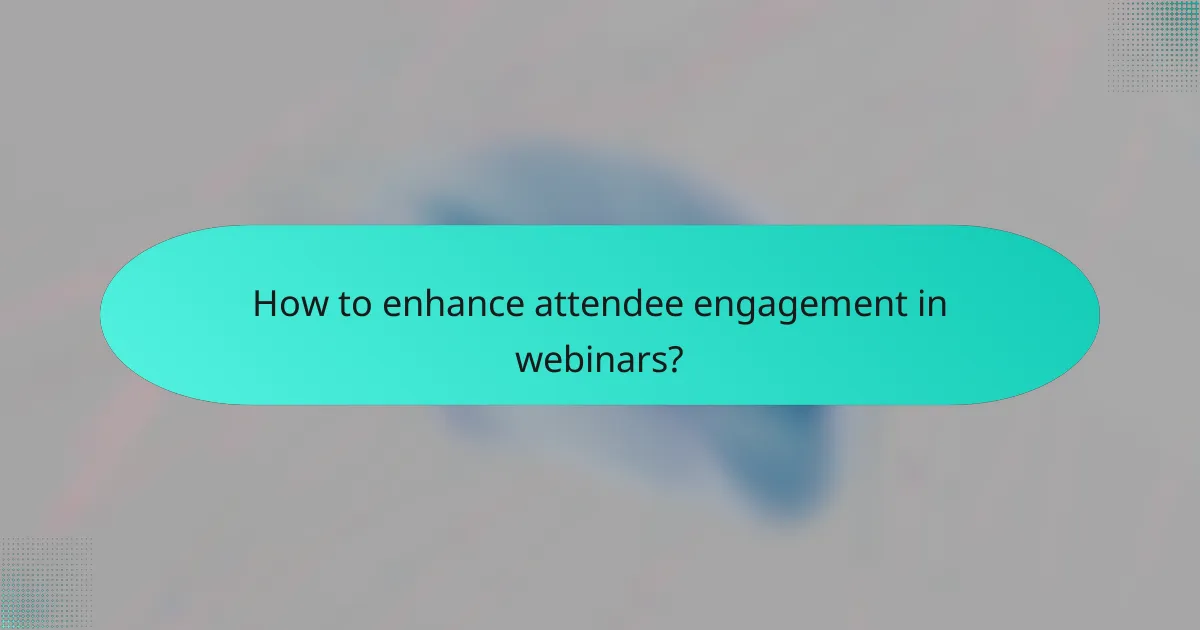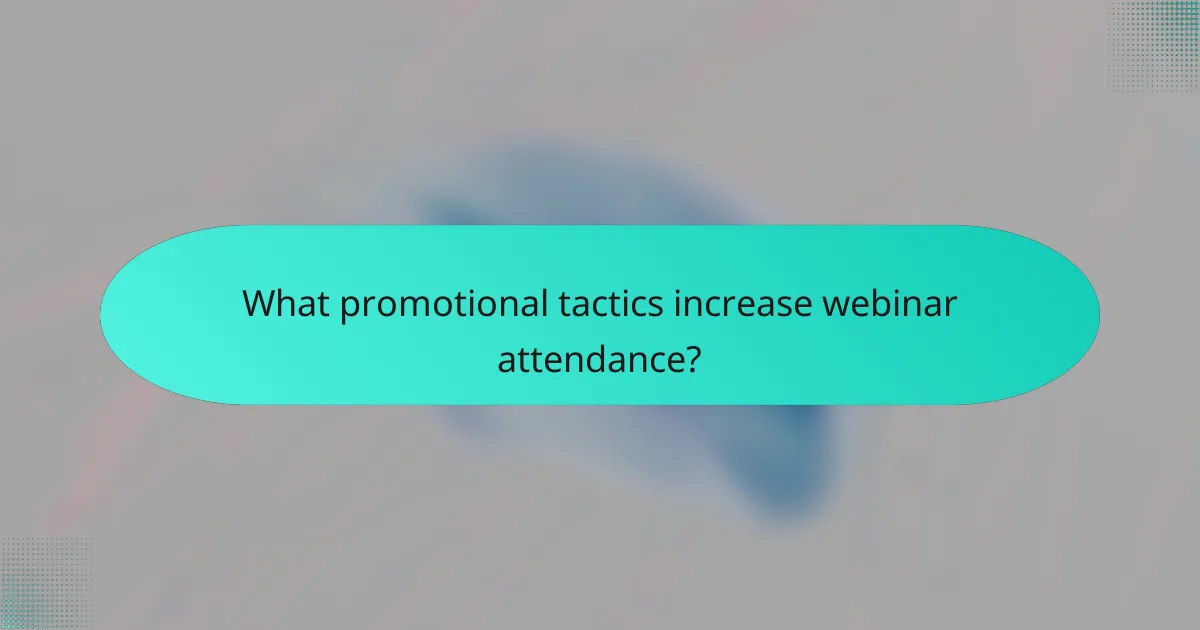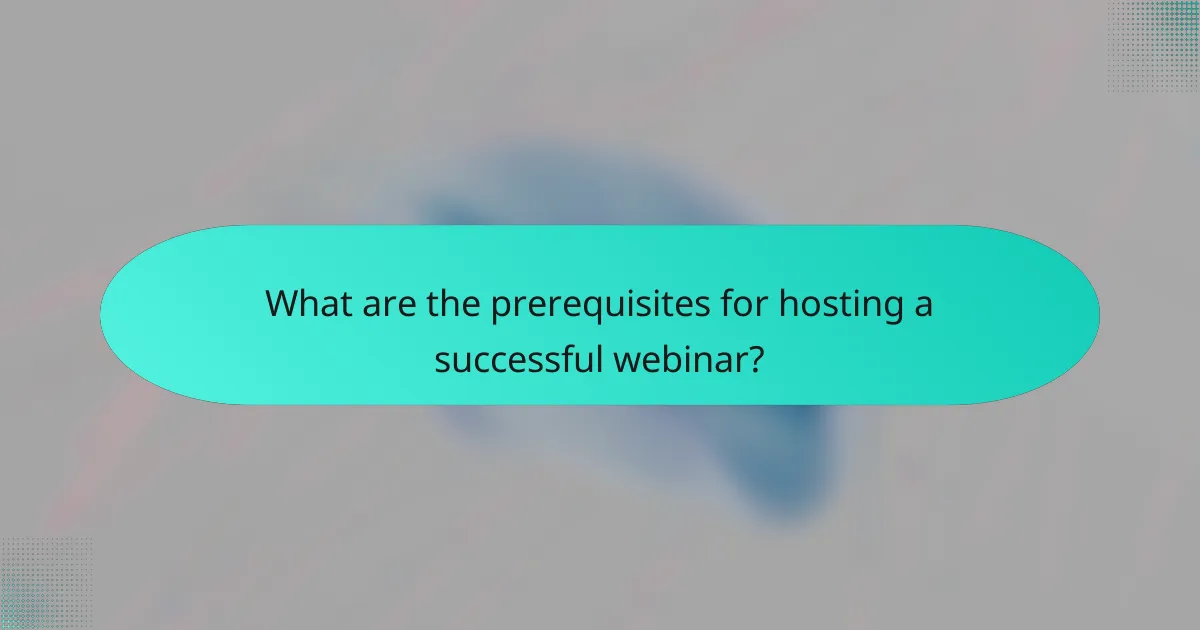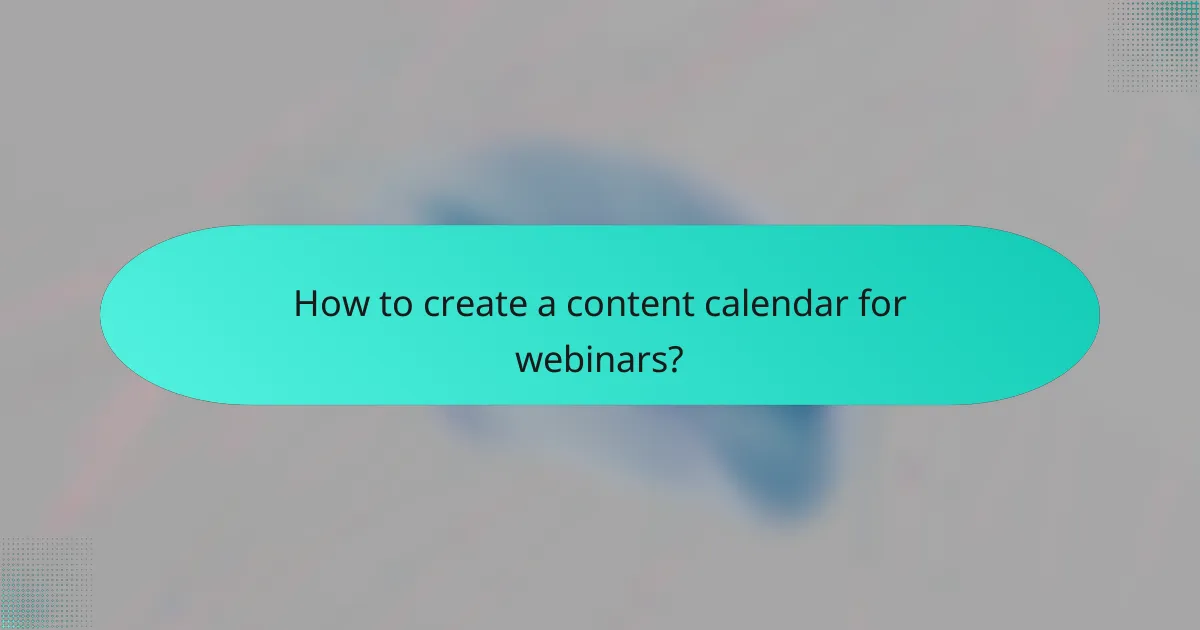Welcome to our Webinar Series, where we focus on enhancing attendee engagement and providing valuable follow-up resources. By implementing interactive strategies and effective promotional tactics, we aim to create meaningful connections and ensure participants leave with a wealth of knowledge and tools to apply. Join us as we explore how to maximize the impact of your webinars and keep your audience engaged long after the event.

How to enhance attendee engagement in webinars?
Enhancing attendee engagement in webinars involves creating interactive experiences that encourage participation and connection. Effective strategies include using polls, personalized follow-ups, and leveraging social media to maintain interest and involvement.
Interactive polls and Q&A sessions
Incorporating interactive polls and Q&A sessions during webinars can significantly boost engagement. Polls allow attendees to express their opinions in real-time, while Q&A sessions provide opportunities for direct interaction with speakers.
To implement this, consider using polling tools that integrate with your webinar platform. Aim to include at least two polls and a dedicated Q&A segment to keep the audience involved throughout the session.
Personalized follow-up emails
Sending personalized follow-up emails after the webinar can enhance attendee engagement by making participants feel valued. Tailor your messages based on their interests or questions raised during the session.
Include a summary of key points, links to the recorded webinar, and additional resources relevant to their interests. This approach can help maintain the connection and encourage future participation.
Exclusive access to additional resources
Providing exclusive access to additional resources can incentivize attendees to engage more deeply with your content. Consider offering downloadable materials, such as eBooks or whitepapers, that complement the webinar topics.
Make these resources available only to webinar participants to create a sense of exclusivity. This can enhance their learning experience and encourage them to share the content with others.
Utilizing social media for interaction
Leveraging social media platforms can enhance engagement before, during, and after the webinar. Create event pages or groups where attendees can discuss topics, share insights, and ask questions.
Encourage participants to use a specific hashtag during the webinar to facilitate conversation and increase visibility. Post-event, share highlights and engage with attendees’ comments to keep the momentum going.

What follow-up resources should be provided?
Providing follow-up resources after a webinar is essential for reinforcing learning and maintaining attendee engagement. Key resources include recorded webinar access, downloadable presentation slides, and supplementary reading materials to enhance understanding and application of the topics discussed.
Recorded webinar access
Offering recorded access to the webinar allows attendees to revisit the content at their convenience. This is particularly beneficial for those who may have missed parts of the live session or wish to review specific segments. Ensure the recording is easily accessible through a link sent via email or hosted on your website.
Consider providing a timestamped table of contents for the recording, enabling viewers to jump directly to sections of interest. This enhances user experience and encourages more thorough engagement with the material.
Downloadable presentation slides
Providing downloadable presentation slides gives attendees a tangible resource to refer back to after the webinar. This can help reinforce key points and serve as a study aid. Make sure the slides are in a widely used format, such as PDF or PowerPoint, to ensure accessibility.
Include any additional notes or annotations on the slides to clarify complex topics. This can enhance understanding and provide context that may not have been fully covered during the live presentation.
Supplementary reading materials
Supplementary reading materials can deepen attendees’ knowledge and provide further insights into the webinar topics. Consider including articles, whitepapers, or case studies that relate directly to the content discussed. These resources can help attendees apply what they learned in practical scenarios.
When selecting supplementary materials, aim for a mix of formats, such as PDFs, links to online articles, or even video resources. This variety caters to different learning preferences and keeps the audience engaged with the subject matter beyond the webinar itself.

What promotional tactics increase webinar attendance?
Effective promotional tactics for increasing webinar attendance include targeted email marketing, social media advertising, and collaborations with industry influencers. These strategies help reach the right audience, enhance engagement, and drive registrations.
Targeted email marketing campaigns
Targeted email marketing campaigns focus on sending personalized invitations to specific segments of your audience. By analyzing past attendance data and interests, you can tailor your messaging to resonate with potential attendees.
Consider using compelling subject lines and clear calls to action. A/B testing different email formats can help identify what works best for your audience, potentially increasing your open and registration rates.
Social media advertising strategies
Social media advertising strategies involve promoting your webinar through paid ads on platforms like Facebook, LinkedIn, and Instagram. These ads can be finely targeted based on demographics, interests, and behaviors, ensuring they reach users likely to be interested in your topic.
Utilize eye-catching visuals and concise messaging to capture attention. Setting a budget that aligns with your goals and monitoring performance metrics will help optimize your campaigns for better results.
Collaborations with industry influencers
Collaborating with industry influencers can significantly boost your webinar’s visibility. Influencers can share your event with their followers, lending credibility and attracting a wider audience.
When selecting influencers, consider their relevance to your topic and their engagement rates. Offering them incentives, such as exclusive access or compensation, can encourage them to promote your webinar effectively.

How to measure the success of a webinar series?
Measuring the success of a webinar series involves evaluating attendee engagement, feedback, and the effectiveness of follow-up offers. By analyzing these aspects, you can identify strengths and areas for improvement, ultimately enhancing future webinars.
Attendee feedback surveys
Attendee feedback surveys are essential for gathering insights directly from participants. Use a mix of quantitative questions, such as rating scales, and qualitative questions to capture detailed opinions. Aim for a response rate of at least 20-30% to ensure your data is representative.
Consider including questions about content relevance, presentation quality, and overall satisfaction. Tools like Google Forms or SurveyMonkey can help streamline the survey process and provide easy-to-analyze results.
Engagement metrics analysis
Engagement metrics provide a quantitative measure of how participants interacted with your webinar. Key metrics include attendance rates, average viewing duration, and participation in polls or Q&A sessions. A good benchmark for attendance is around 30-50% of registrants, while an average viewing duration of 60-70% of the total webinar length indicates strong engagement.
Utilize analytics tools available on webinar platforms to track these metrics. Regularly reviewing engagement data can help you identify trends and adjust your content or delivery methods for future sessions.
Conversion tracking for follow-up offers
Tracking conversions from follow-up offers is crucial for assessing the effectiveness of your webinar series in driving desired actions. Set clear goals for what you want attendees to do post-webinar, such as signing up for a newsletter or purchasing a product. Use tracking links or unique discount codes to monitor these conversions accurately.
Analyze conversion rates to determine the success of your follow-up strategies. A conversion rate of 5-10% is generally considered effective, but this can vary based on your industry and the nature of the offer. Adjust your follow-up tactics based on what resonates most with your audience.

What are the prerequisites for hosting a successful webinar?
To host a successful webinar, you need to ensure you have the right technology, clear objectives, and engaging content. These elements are crucial for attracting attendees and keeping them engaged throughout the session.
Choosing the right webinar platform
Selecting an appropriate webinar platform is essential for a smooth experience. Consider factors such as user interface, features, and pricing. Popular platforms include Zoom, GoToWebinar, and Webex, each offering different capabilities suited for various audience sizes.
Evaluate the platform’s capacity for interactive features like polls, Q&A sessions, and breakout rooms. These tools can significantly enhance attendee engagement and participation.
Defining clear objectives and goals
Establishing clear objectives and goals is vital for guiding your webinar’s content and structure. Determine what you want to achieve, whether it’s educating your audience, generating leads, or promoting a product.
Use the SMART criteria—Specific, Measurable, Achievable, Relevant, and Time-bound—to set your goals. This approach helps ensure your objectives are clear and attainable, making it easier to measure success afterward.
Preparing engaging content
Creating engaging content is key to keeping your audience interested. Start by outlining your main points and supporting information, ensuring they align with your objectives. Use visuals, stories, and examples to make your content relatable and memorable.
Consider incorporating interactive elements, such as quizzes or live polls, to maintain engagement. Aim for a balance between informative and entertaining content to cater to different learning styles and preferences.

How to create a content calendar for webinars?
Creating a content calendar for webinars involves planning and organizing topics, dates, and promotional activities to ensure consistent engagement and effective follow-up. A well-structured calendar helps streamline the process and keeps your audience informed and interested.
Identifying key topics and themes
Start by researching your audience’s interests and pain points to identify relevant topics for your webinars. Consider using surveys or feedback forms to gather insights directly from attendees. Aim for a mix of foundational themes and trending subjects to maintain engagement.
Once you have a list of potential topics, categorize them into themes that align with your overall goals. For example, if your webinars focus on digital marketing, you might explore themes like SEO, social media strategies, and content creation. This approach helps create a cohesive series that builds on each session.
Scheduling regular sessions
Establish a consistent schedule for your webinars to build anticipation and routine among your audience. Depending on your resources and audience preferences, consider hosting sessions weekly, bi-weekly, or monthly. Regularity helps attendees plan their participation and increases overall engagement.
When scheduling, take into account time zones and typical availability of your target audience. For instance, if your audience is primarily in the US and Europe, choose times that accommodate both regions, such as late morning or early afternoon EST. Additionally, be mindful of holidays and major events that might conflict with attendance.
